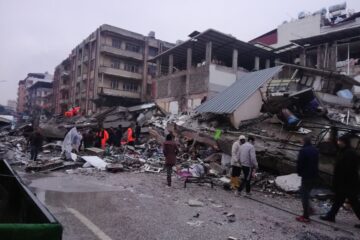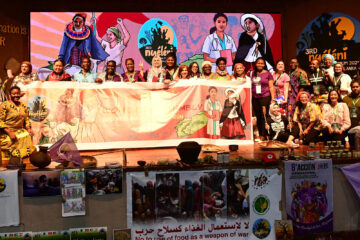Learning about experiences of grassroots feminist reconstruction from different territories allows us to formulate collective starting points and ways to reorganize life in face of extreme climate events. The World March of Women understands that these extreme events are not disconnected from the causes of climate change, but are actually part of the current model of reproduction, production, and consumption under the system of multiple oppressions, and they aggravate the capital-life conflict. Through women’s collective organizing, we establish practices and initiatives that are centered around solidarity to ensure the sustainability of life under harsh conditions. The webinar “Experiences of Feminist Reconstruction After Environmental Disasters” featured women from Brazil, Haiti, Cuba, and Turkey sharing experiences of reconstruction. Across these territories, we combine practices of reconstruction and feminist solidarity with a political agenda that tackles the dynamics of capital expansion. This webinar was held on September 29th and was organized by Capire in partnership with Brazilian organizations that are members of the World March of Women, SOF Sempreviva Feminist Organization and CF8 March 8 Feminist Center. Read below the contribution by Elpidia Moreno, from the World March of Women Cuba.

Cuba, as a Caribbean country, frequently faces natural phenomena such as hurricanes, droughts, and tornadoes. Every year, our communities prepare to face them. Since its establishment, the country’s civil defense system has primarily aimed to generalize and systematize experiences in disaster management, based on national and international expertise. Together with social organizations, it plays a fundamental role in preparedness, response, and recovery from these events.
September 29th, 2025 [date of speech] marks the 62nd anniversary of Hurricane Flora, which marked a turning point for Cuba. All forces had to be mobilized to address it. Unfortunately, more than a thousand people died, and the economy was severely hurt.
That mobilization showed how much can be done to mitigate the damage caused by a natural disaster. The leadership of Commander Fidel Castro, who personally directed rescue operations—even risking his own life—was decisive. His first-hand experience on the ground provided an understanding of the dimensions of the disaster and the urgency of structural transformation.
The participation of the Revolutionary Armed Forces, along with medical and support brigades, was also crucial. Their massive mobilization marked the beginning of a culture of organized emergency response. In the wake of Hurricane Flora, meteorological systems were enhanced, dam and reservoir construction programs were created, and the civil defense system was structured as a national prevention and response mechanism.
Moreover, evacuation protocols, shelter centers, and community surveillance networks were established, which today are pillars of risk management in Cuba. Hurricane Flora left a deep mark on the Cuban collective consciousness. Since then, each hurricane season is faced with preparation and active community participation.
This experience has made Cuba an international point of reference in disaster risk reduction, particularly focused on protecting human lives. While Hurricane Flora was a tragedy, it was also a historical lesson. Its impact catalyzed the development of a national risk management system that has saved thousands of lives. Preparing for hurricanes in Cuba is no longer a reaction—it is a culture.
Cuban women have played a fundamental role in preparing for, responding to, and recovering from these events. Their work is essential to community resilience. It also means ensuring the preservation of lives and the conservation of economic and natural resources.
Cuban women do not wait for the storm to hit before taking action. From their neighborhoods, medical clinics, schools, and Committees for the Defense of the Revolution, along with federated women, they organize evacuations, protect the most vulnerable, store food and medicine, and ensure that no one is left behind.
When disaster strikes, women are on the front lines. Not only do they take care of their families, but they also extend their help to those in need. They cook for brigades, care for children and the elderly, improvise shelters, and often do so without resources, but with unwavering determination.

After the Disaster Comes Reconstruction and Hope
After the storm is gone, another battle begins: rebuilding. And there they are again, leading the way. Women repair houses, reorganize daily lives, reactivate support networks, and, above all, provide emotional support to those who have lost so much.
A prime example was the January 2019 tornado in Havana. Amid the destruction, many women organized community kitchens, offered shelter, and coordinated aid with an efficiency that only true commitment to moving forward can provide.
In recent years, Cuba has made progress in incorporating a gender perspective into disaster management. Programs have been created to train women in leadership, first aid, and emergency planning. This not only strengthens the community response but also empowers women as agents of change.
Cuban women do not just face natural disasters: they transform them with strength, creativity, and solidarity. They rebuild not only houses, but also hope. Recognizing their work is not a symbolic gesture: it is an act of justice.
The Federation of Cuban Women has trained women on issues including gender equality, violence prevention, self-care, and the local economy. These initiatives have empowered women to actively participate in decision-making and risk management policy planning.
Women face unique challenges: greater exposure to violence in temporary shelters, impacts on sexual and reproductive health, and an overload of domestic work. However, their active participation in post-disaster recovery offers an opportunity to reduce gender inequalities and strengthen social cohesion.
Strategic Planning in Defense of Life
A community manual on inclusive management for disaster risk reduction has been designed and published. This educational tool incorporates prevention and response strategies for different types of natural disasters drawing from the perspectives of gender, children, and people with disabilities, with an emphasis on families and educational institutions. At the same time, it encourages and promotes awareness of environmental protection.
Life Task [Tarea Vida] is being developed despite the effects of the economic, commercial, and financial blockade the United States government has imposed for more than 60 years. Life Task, consisting of five strategic actions and eleven short-, medium-, and long-term tasks, combines decisions at the highest level with decentralized management at the sectoral and territorial levels, focusing on the protection of human life, with quality and a gender perspective.
In March 2021, the National Program for the Advancement of Women was adopted by presidential decree as part of the Cuban government’s agenda. The program seeks to achieve greater comprehensiveness and effectiveness in preventing and eliminating manifestations of discrimination. It is coordinated with the country’s programs, plans, and projects related to climate change. It promotes the economic empowerment of women, their access to land and other natural resources, as well as greater participation in urban, suburban, and family agriculture.
The Solidarity of the Cuban People
A large number of women in Cuba are heads of risk reduction management centers and responsible for early warning points on the ground. In Cuba, one thing is certain amid this inevitable scenario: the solidarity that emanates spontaneously and multiplies among its people. Names including Flora, Ike, Denis, Matthew, Sandy, Irma, Oscar, and Rafael reaffirm that Cubans have a long history of facing devastating cyclones and tropical storms.
And in each episode, there are also hundreds of stories of sisterhood between neighbors to protect each other in times of great tension. They also count on the help of friends and family to take in the belongings of those who do not have a safe roof over their heads. In difficult times, brought on by a hurricane or tropical storm, solidarity becomes an anticyclone of love and hope.
There are many anecdotes that reflect the solidarity between Cubans: the teacher who, a few years ago, turned her home into a school so that children would not miss classes due to a lack of classrooms after Hurricane Irma; or the moving videos that, after Hurricane Oscar, show three residents of Guantánamo braving the raging river in the middle of town to save an elderly man from the floodwaters. Added to these, as on many other occasions, is the arrival of the essential support of brigades to the most damaged areas, where they restore electricity, water, and telephone services, access to roads, and hope to neighborhoods and communities.
Deepening the Work
We must continue to incorporate a gender perspective across all levels of risk management. We must more rigorously apply protocols to prevent violence in evacuation shelters and work harder to achieve sanitary conditions that guarantee women’s well-being. We must continue to promote technical training and leadership for women in response brigades and foster support networks among women to share knowledge and experiences.
Hurricanes and other natural disasters will continue to hit Cuba. We cannot prevent them, but Cuban women will face them, bring their efforts together, weave support networks, and raise the banners of humanism and solidarity. Because Cuban women are stronger than a cyclone, than a hurricane, than an earthquake, than a tornado. We are Cuban women.
Elpidia Moreno is a member of the World March of Women in Cuba.




